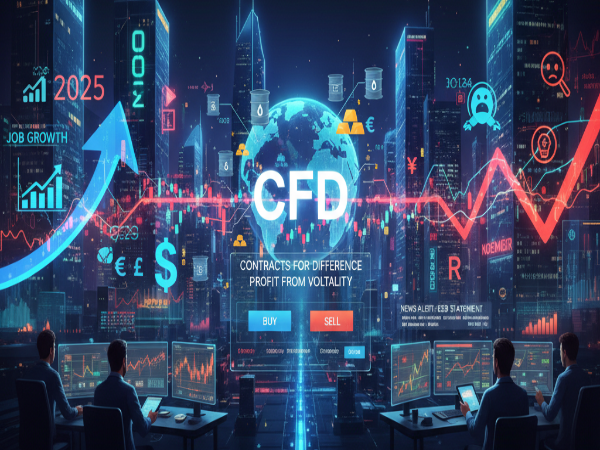November 2025: Financial News, Key Market Dates, and CFD Trading Opportunities

November 2025 opens with pivotal market events shaping stocks, currencies, and commodities. From central bank moves to renewed volatility, traders eye CFD opportunities amid shifting global conditions.
November 2025 arrives as one of the most critical months of the financial calendar. With the global economy in a delicate balance between slowing inflation and uneven growth, markets are positioning ahead of the final quarter. Traders across equities, forex, and commodities are adjusting strategies to navigate policy updates, earnings, and macroeconomic releases that could redefine short-term sentiment. The financial landscape this month reflects a tug-of-war between optimism over stabilizing prices and anxiety about sluggish consumer demand and tightening liquidity.
The first half of November began with cautious optimism following better-than-expected U.S. employment data, confirming that job creation remains steady even as wage growth moderates. In Europe, attention has turned toward the European Central Bank, whose upcoming statements are expected to clarify whether interest rates have peaked after a year of gradual easing. The Bank of England faces a similar dilemma, balancing the risk of reigniting inflation against a visible cooling in the housing and retail sectors. In Asia, the People’s Bank of China has continued targeted liquidity injections to support credit growth, signaling a more interventionist stance to stabilize domestic consumption before the Lunar New Year period.
Beyond policy, several key earnings announcements are drawing investor focus. Technology and energy remain the most closely watched sectors, with large-cap U.S. firms reporting robust Q3 margins despite cost pressures. Meanwhile, European industrials have shown resilience in exports, benefiting from a softer euro and recovering logistics chains. November also brings the last wave of third-quarter corporate reports in Japan and Australia, both reflecting divergent trends: Japanese manufacturers see rising output on semiconductor demand, while Australian miners remain exposed to volatile commodity prices.
Commodity markets are entering a period of renewed speculation. Oil prices have fluctuated sharply in the first week of November, as traders weigh OPEC’s supply management against weakening global demand. Brent crude has hovered near the $80 mark, with intraday volatility increasing on every geopolitical headline. Gold, on the other hand, continues to attract safe-haven inflows amid uncertainty in global equity markets, testing multi-month resistance levels around $2,000 an ounce. For day traders and institutional desks alike, commodities are setting the tone for short-term macro sentiment, acting as barometers of both inflation and fear.
Currency markets are equally dynamic. The U.S. dollar remains firm but shows early signs of exhaustion, with traders anticipating a softer stance from the Federal Reserve in its mid-November policy meeting. The euro’s recovery has been fragile, constrained by weaker manufacturing data from Germany and France. The British pound, having stabilized after months of volatility, is now more sensitive to domestic fiscal announcements than to global macro shifts. In emerging markets, currencies like the Brazilian real and Indian rupee have been surprisingly stable, supported by higher bond inflows and cautious central bank management. As investors rebalance portfolios ahead of year-end, November’s foreign exchange moves could foreshadow 2026’s early trends.
In the equity space, volatility indices have ticked upward, reflecting heightened uncertainty. U.S. stocks are oscillating between optimism over potential rate cuts in early 2026 and concern about margin compression. European markets remain defensive, with investors favoring utilities and healthcare over cyclical sectors. Asian equities show greater divergence: while Japan enjoys renewed interest from foreign investors, China’s markets remain subdued despite policy easing. The broader sentiment across exchanges is one of anticipation — traders expect that November’s data will determine whether the final quarter closes with a rally or correction.
As financial markets digest this dense flow of information, November stands out as a month where short-term trading opportunities are abundant, but precision is essential. Economic calendars are packed with decision points — inflation data from the U.S. and EU, industrial output figures from Asia, and the Fed’s final statements before December’s policy shift. Each release carries the potential to move entire asset classes within hours. For professionals in the trading ecosystem, this month demands heightened adaptability and an understanding that momentum can turn on a single data point.
CFD Opportunities in a Volatile Market
Contracts for Difference (CFDs) are particularly suited to the kind of volatility that defines November 2025. As global markets swing between optimism and caution, CFDs allow traders to speculate on short-term movements across equities, indices, commodities, and currencies without holding the underlying assets. This flexibility is crucial when market direction is uncertain but volatility is high — the exact environment traders face this month.
CFDs enable both long and short exposure, giving investors the ability to react instantly to news such as policy decisions, corporate earnings, or unexpected geopolitical developments. For instance, traders can capitalize on rapid oil price fluctuations by taking directional positions within minutes of OPEC announcements, or exploit intraday movements in the euro-dollar pair following central bank statements. Because CFDs often involve leverage, they amplify potential returns — but also magnify losses — making disciplined risk management essential.
In the current market, the most effective CFD strategies focus on momentum confirmation and controlled exposure. Traders are combining technical triggers like moving average crossovers with real-time macro alerts to capture short-lived bursts of volatility. The interplay between data releases and liquidity cycles in November offers fertile ground for these rapid strategies, but success hinges on structure rather than intuition.
Ultimately, CFD trading in November 2025 is not about predicting where the market will end the month, but about interpreting its rhythm day by day. The best opportunities emerge from volatility, not stability, and November’s global financial climate provides exactly that. In this phase of transition — between tightening and easing, between fear and confidence — the agility offered by CFDs can turn uncertainty itself into a strategic advantage.



